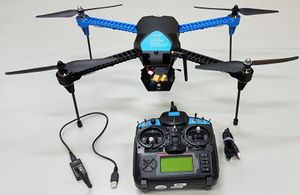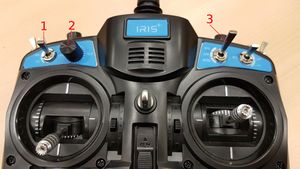Difference between revisions of "Iris"
Hjkarssies (talk | contribs) |
|||
| (9 intermediate revisions by 3 users not shown) | |||
| Line 4: | Line 4: | ||
= Introduction = | = Introduction = | ||
The Iris+ drone was manufactured by 3DR and is based around the Pixhawk autopilot. Paparazzi [ | The Iris+ drone was manufactured by 3DR and is based around the Pixhawk autopilot. Paparazzi [[Pixhawk|supports]] the Pixhawk hardware, and this page serves as simple step-by-step guide to get a Pixhawk based drone flying on with the Paparazzi autopilot. In this example, only standard Pixhawk hardware is used, as it comes delivered with the stock Iris. | ||
=Videos= | |||
Paparazzi UAV Iris+ Pixhawk tutorial videos - by the [http://mavlab.lr.tudelft.nl/ TU Delft MAVLab] <br> | |||
{{#ev:youtubeplaylist|PL_KSX9GOn2P-CVsy-lRSHAnUwVF9wI_pZ}} | |||
<br style="clear:both"> | |||
= Getting the Iris flight ready= | = Getting the Iris flight ready= | ||
| Line 12: | Line 17: | ||
# Its stock 3DR radio's and 3DR RC. | # Its stock 3DR radio's and 3DR RC. | ||
# The Pixhawk should still contain the PX4 / APM bootloader. | # The Pixhawk should still contain the PX4 / APM bootloader. | ||
# A computer with Paparazzi [ | # A computer with Paparazzi [[Installation|installed]]. | ||
# A micro USB cable. | # A micro USB cable. | ||
# Optional: the 3DR Tarrot Gimbal and a GoPro 3. | # Optional: the 3DR Tarrot Gimbal and a GoPro 3. | ||
| Line 18: | Line 23: | ||
Steps you will need to perform: | Steps you will need to perform: | ||
# Plug in the USB cable to the Iris. <b>Remove the props. Leave the battery disconnected.</b> | # Plug in the USB cable to the Iris. <b>Remove the props. Leave the battery disconnected.</b> | ||
# Flash both the AP and FBW. | # Flash both the AP and FBW. [[Pixhawk#Flashing|On how to flash, follow this link here]] | ||
# Power cycle the Pixhawk (e.g. replug USB). | # Power cycle the Pixhawk (e.g. replug USB). | ||
# Make sure to set the target to AP again, and build. | # Make sure to set the target to AP again, and build. Uploading is not necessary, this step is required to prevent md5 checksum errors. | ||
# Plug in the 3DR radio to the computer. Select USB0 session in Paparazzi Center. | # Plug in the 3DR radio to the computer. Select the <i>Flight USB0 @57600</i> session in Paparazzi Center, and click execute. Paparazzi GCS will start. | ||
# Calibrate the | # [[ImuCalibration|Calibrating the Magnetometer]] and [[#Calibrate the ESCs | calibrate the ESCs]] of the Iris+. | ||
==Calibrate the ESCs== | ==Calibrate the ESCs== | ||
The original PX4 firmware calibrates the ESCs automatically, paparazzi does not support this. Therefor it is needed to calibrate the ESCs manually. For this two options are available: | The original PX4 firmware calibrates the ESCs automatically, paparazzi does not support this. Therefor it is needed to calibrate the ESCs manually. For this two options are available: | ||
* Calibrate by using a servo tester | * Calibrate by using a servo tester (see page [[Actuator Dynamics]]) | ||
* Calibrate using <i> mode RC direct</i> | * Calibrate using <i> mode RC direct</i> | ||
The first option requires the user to have a servo tester, open up the Iris+ and disconnect wires. Therefor, this wiki describes the second option. | The first option requires the user to have a servo tester, open up the Iris+ and disconnect wires. Therefor, this wiki describes the second option. | ||
In order to use the RC direct mode, a change is required in the airframe xml configuration. Comment or temporarily remove the following line: | In order to use the <i>RC direct mode</i>, a change is required in the airframe xml configuration. Comment or temporarily remove the following line: | ||
{{Box Code|conf/airframes/TUDELFT/tudelft_iris_indi.xml|<source lang="xml"> | {{Box Code|conf/airframes/TUDELFT/tudelft_iris_indi.xml|<source lang="xml"> | ||
<define name="FBW_MODE_AUTO_ONLY" value="true"/> | <define name="FBW_MODE_AUTO_ONLY" value="true"/> | ||
Latest revision as of 14:34, 24 October 2020
Introduction
The Iris+ drone was manufactured by 3DR and is based around the Pixhawk autopilot. Paparazzi supports the Pixhawk hardware, and this page serves as simple step-by-step guide to get a Pixhawk based drone flying on with the Paparazzi autopilot. In this example, only standard Pixhawk hardware is used, as it comes delivered with the stock Iris.
Videos
Paparazzi UAV Iris+ Pixhawk tutorial videos - by the TU Delft MAVLab
Getting the Iris flight ready
You'll need:
- The stock Iris drone, (equipped with the Pixhawk),
- Its stock 3DR radio's and 3DR RC.
- The Pixhawk should still contain the PX4 / APM bootloader.
- A computer with Paparazzi installed.
- A micro USB cable.
- Optional: the 3DR Tarrot Gimbal and a GoPro 3.
Steps you will need to perform:
- Plug in the USB cable to the Iris. Remove the props. Leave the battery disconnected.
- Flash both the AP and FBW. On how to flash, follow this link here
- Power cycle the Pixhawk (e.g. replug USB).
- Make sure to set the target to AP again, and build. Uploading is not necessary, this step is required to prevent md5 checksum errors.
- Plug in the 3DR radio to the computer. Select the Flight USB0 @57600 session in Paparazzi Center, and click execute. Paparazzi GCS will start.
- Calibrating the Magnetometer and calibrate the ESCs of the Iris+.
Calibrate the ESCs
The original PX4 firmware calibrates the ESCs automatically, paparazzi does not support this. Therefor it is needed to calibrate the ESCs manually. For this two options are available:
- Calibrate by using a servo tester (see page Actuator Dynamics)
- Calibrate using mode RC direct
The first option requires the user to have a servo tester, open up the Iris+ and disconnect wires. Therefor, this wiki describes the second option.
In order to use the RC direct mode, a change is required in the airframe xml configuration. Comment or temporarily remove the following line:
| File: conf/airframes/TUDELFT/tudelft_iris_indi.xml |
<define name="FBW_MODE_AUTO_ONLY" value="true"/>
|
Optionally: change the following lines in the section AUTOPILOT:
| File: conf/airframes/TUDELFT/tudelft_iris_indi.xml |
<define name="MODE_STARTUP" value="AP_MODE_ATTITUDE_DIRECT" />
<define name="MODE_MANUAL" value="AP_MODE_ATTITUDE_DIRECT" />
|
to:
| File: conf/airframes/TUDELFT/tudelft_iris_indi.xml |
<define name="MODE_STARTUP" value="AP_MODE_RC_DIRECT" />
<define name="MODE_MANUAL" value="AP_MODE_RC_DIRECT" />
|
This last step is not required, but properly communicates the new mode to the GCS software.
Important: for safety it is strongly recommended to remove the propellers
Build and upload the FBW firmware, and if the optional steps were taken, also build and upload the AP.
The system is now ready to calibrate the ESCs. Perform the following steps:
- Power off the Iris+
- On the RC
- Set the set radio mode (switch 3 in figure 2) to std
- Disable manual kill by setting the kill switch (switch 1 in figure 2) to on
- Put the throttle to max.
- Turn on the RC
- Plug in the usb cable to the Iris+. The AP can now boot.
- Wait approximately 10 seconds until the leds blinks slow (once per second).
- Plug in the battery to the Iris+ (with props removed!). You should hear a beep coming from the ESCs.
- On the RC, put the throttle to zero. You should hear confirmation beeps from the ESCs.
- Validate the range of the throttle stick by slowly throttling up to max. The motors should spin accordingly.
- Revert the changes made to the airframe xml, and upload the firmware(s).

